前言
最近学校要求使用粤嵌的开发板实现电子相册,具体的功能要有点击特定的区域实现上一张、下一张、自动播放图片、黑屏退出应用程序、左右滑动切换图片相关功能。其中涉及到的知识点也比较多(文件IO、内存映射、触摸屏、bmp图片格式、进程、线程创建和同步、字符串操作等)。为理清思路和复习去年学的Linux C应用编程知识,特写下此文进行回顾和总结。
先看看效果
粤嵌Linux GEC6818开发板实现电子相册
整个工程文件和使用到的图片在下方链接
门牙会稍息 / 粤嵌GEC 6818开发板实现简易电子相册和音乐播放器 · GitCode
一:内存映射
存储映射 I/O(memory-mapped I/O)是一种基于内存区域的高级 I/O 操作,它能将一个文件映射到进程地址空间中的一块内存区域中,当从这段内存中读数据时,就相当于读文件中的数据(对文件进行 read 操作),将数据写入这段内存时,则相当于将数据直接写入文件中(对文件进行 write 操作)。用到的两个函数是mmap和munmap,函数原型如下:

简言之addr设置为NULL的话内核会自动找一内存空间,大小就是length,粤嵌的屏是800*480的,所以length就是800*480*4,4代表一个像素点由四字节构成(ARGB),port参数设为PROT_READ、PROT_WRITE就是可读可写,flags描述的是映射区的属性。
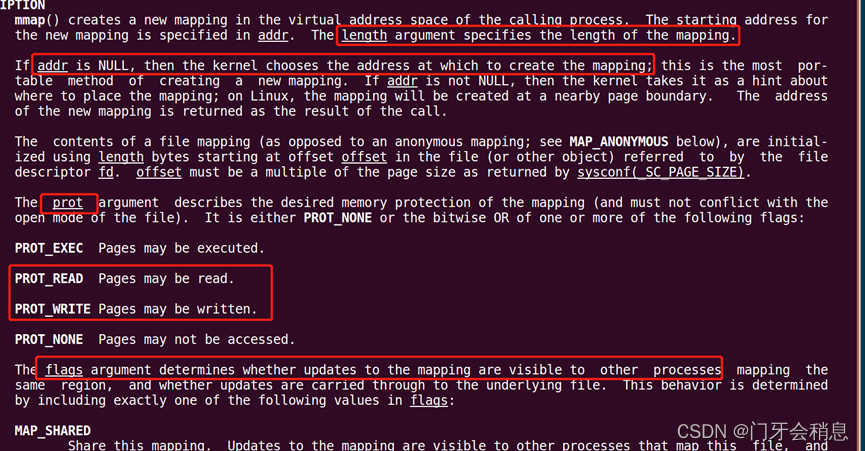
二:BMP格式图片
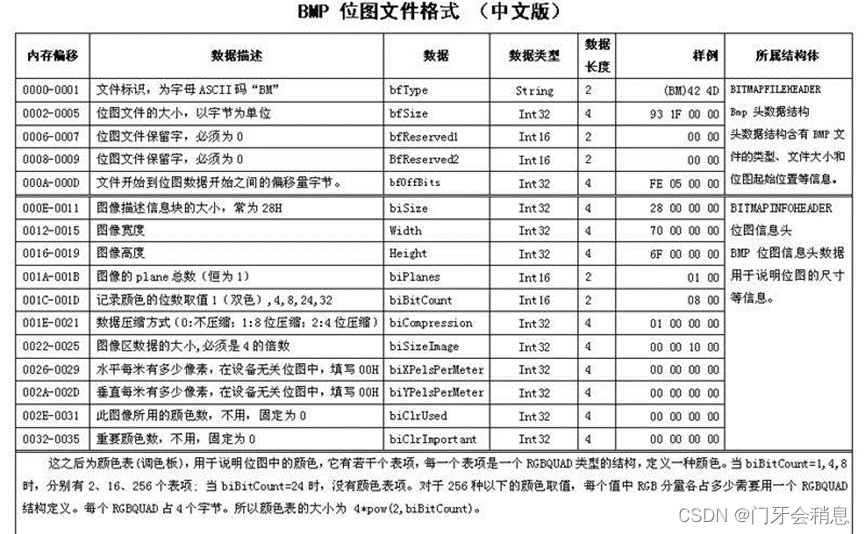
用hexdump查看一下bmp图片的数据(高度和宽度)

LCD屏显示BMP格式图片的函数
/**
*lcd屏显示bmp格式图片函数
*@param pathname 图片名字
*@param x0 图片在LCD上显示的x起点坐标
*@param y0 图片在LCD上显示的y起点坐标
*@return 函数返回值
*/
int lcd_show_bmp(char *pathname, int x0, int y0)
{
//1、打开设备文件
int lcd = open("/dev/fb0", O_RDWR);
if(-1 == lcd)
{
printf("lcd open error!\n");
return -2;
}
//2、内存映射
char *ptr = (char *)mmap(NULL, 800*480*4, PROT_READ|PROT_WRITE,
MAP_SHARED, lcd, 0);
if(NULL == ptr)
{
printf("mmap error!\n");
return -3;
}
//清除背景色
//bzero(ptr, 800*480*4);
//打开图片
int bmp = open(pathname, O_RDWR);
if(-1 == bmp)
{
printf("bmp open error!\n");
return -2;
}
//读取图片相关信息
int bmp_size, bmp_width, bmp_height;
//大小
lseek(bmp, 2, SEEK_SET);
read(bmp, &bmp_size, sizeof(bmp_size));
//宽度和高度
lseek(bmp, 18, SEEK_SET);
read(bmp, &bmp_width, sizeof(bmp_width));
read(bmp, &bmp_height, sizeof(bmp_height));
//读取图片的颜色数据
lseek(bmp, 54, SEEK_SET);
char *bmp_buf = malloc(bmp_size); //申请空间
read(bmp, bmp_buf, bmp_width*bmp_height*3);
//对颜色数据进行处理(上下颠倒以及数据混乱)
int bmp_sum = 0;
int lcd_sum = 0;
for(int y=0; y+y0<480 && y<bmp_height; y++)
{
for(int x=0; x+x0<800 && x<bmp_width; x++)
{
bmp_sum = 3*(x+((bmp_height-1-y)*bmp_width));
lcd_sum = 4*(800*(y+y0)+x+x0);
//等号的坐标属于lcd屏幕, 等号的右边是bmp图像数据
ptr[lcd_sum+0] = bmp_buf[bmp_sum+0]; //蓝色数据
ptr[lcd_sum+1] = bmp_buf[bmp_sum+1]; //绿色数据
ptr[lcd_sum+2] = bmp_buf[bmp_sum+2]; //红色数据
ptr[lcd_sum+3] = bmp_buf[bmp_sum+3]; //透明度数据
}
//usleep(1);
}
//释放相关资源
munmap(ptr, 800*480*4);
free(bmp_buf);
//3、关闭文件
close(lcd);
close(bmp);
}三:input_event接收触摸屏上报值
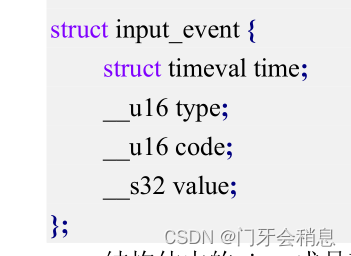
用hexdump命令查看触摸屏上报值


此实验用到input子系统中的type、code(下面的图片来源Linux内核中的input.h文件)

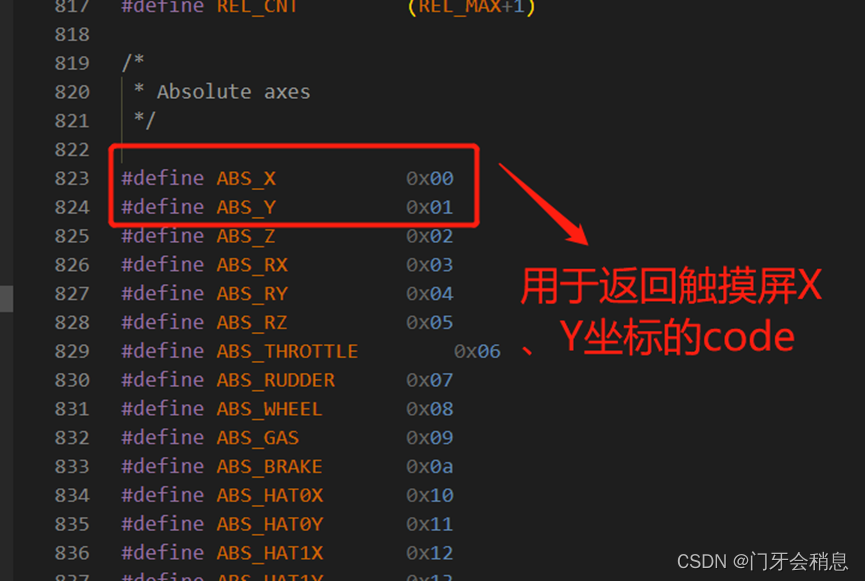
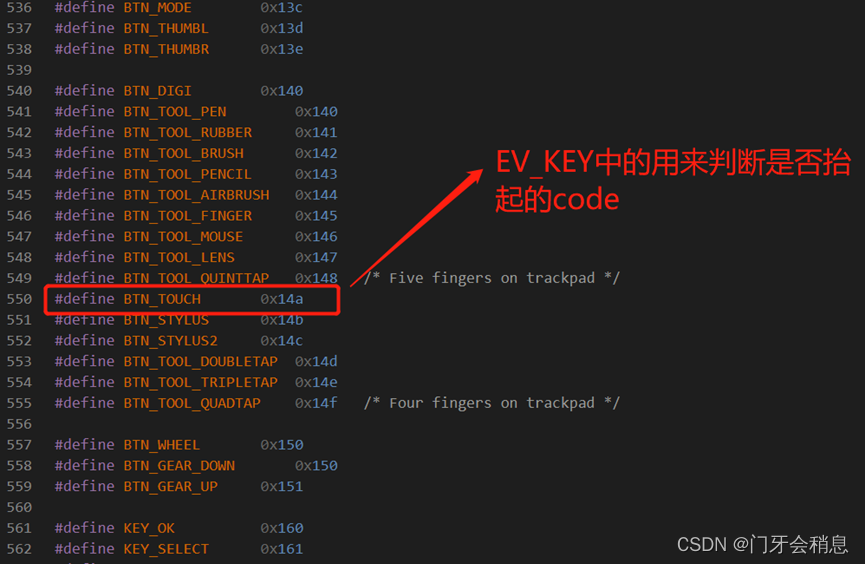
获取触摸屏坐标返回值函数
/**
*获取触摸屏坐标返回值函数
*param NULL
*return NULL
*/
void get_touch()
{
//打开设备文件
int touch_fd = open("/dev/input/event0", O_RDONLY);
if(-1 == touch_fd)
{
printf("event0 open error!\n");
}
while(1)
{
read(touch_fd, &ts, sizeof(ts));
//获取X、Y坐标
if(EV_ABS == ts.type) //判断是否为触摸屏事件
{
if(ABS_X == ts.code)//判断是否为x轴数据
{
ts_x = ts.value;
flag_x = 1;
}
else if(ABS_Y == ts.code) //判断是否为y轴数据
{
ts_y = ts.value;
flag_y = 1;
}
}
if(EV_KEY == ts.type)
{
//刚触碰的坐标/长按时
if(ts.code == BTN_TOUCH && ts.value == 1)
{
old_x = ts_x;
first_press_flag = 1;
}
}
if(flag_x == 1 && flag_y == 1 && first_press_flag == 1)
{
flag_x = 0;
flag_y = 0;
pthread_mutex_lock(&mutex);
flag_x_y = 1;
//黑色底板才需要执行如下操作
ts_x = ts_x*800/1024;
ts_y = ts_y*480/600;
pthread_mutex_unlock(&mutex);
pthread_cond_signal(&cond);
//break;
}
if(EV_KEY == ts.type)
{
//松开
if(ts.code == BTN_TOUCH && ts.value == 0)
{
//从左到右的滑动
if(((ts_x > old_x) && (ts_x - old_x > 150) && (ts_x < 600)))
{
right_left_slide_flag = 1;
slider_right = 1;
old_x = 300;
}
//从右到左的滑动
else if(((old_x > ts_x) && (old_x - ts_x > 150) && (old_x < 600)))
{
right_left_slide_flag = 1;
slider_left = 1;
old_x = 300;
}
}
}
}
//4、关闭文件
close(touch_fd);
}四:创建线程,处理触摸屏坐标数据
阻塞式 I/O 的优点在于能够提升 CPU 的处理效率,当自身条件不满足时,进入阻塞状态,交出 CPU资源,将 CPU 资源让给别人使用;而非阻塞式则是抓紧利用 CPU 资源,譬如不断地去轮训,这样就会导致该程序占用了非常高的 CPU 使用率!我这里是想获得触摸点坐标之后再做相关的操作,当没有按下触摸屏的时候,相关线程就会阻塞挂起,节约资源,线程同步中使用互斥锁和条件变量就可以实现。
左右滑动线程处理函数:
void *right_left_slide_func(void *arg)
{
printf("enter right_left_slide_func\r\n");
while(1){
if(right_left_slide_flag == 1){
if(slider_left == 1){
touch_flag--;
if(touch_flag <= 0)
touch_flag = BMP_MAX_NUMBER;
lcd_show_bmp(bmp_path[touch_flag - 1], 0, 0);
slider_left = 0;
right_left_slide_flag == 0;
}
else if(slider_right == 1){
touch_flag++;
if(touch_flag > BMP_MAX_NUMBER)
touch_flag = 1;
lcd_show_bmp(bmp_path[touch_flag - 1], 0, 0);
slider_right = 0;
right_left_slide_flag == 0;
}
right_left_slide_flag == 0;
}
}
}右侧选项框线程处理函数:
void *area_switch(void *arg)
{
printf("enter area_switch\r\n");
while(1){
pthread_mutex_lock(&mutex);
while(flag_x_y == 0)
pthread_cond_wait(&cond, &mutex);
while(flag_x_y == 1){
//上一张
if((ts_y > 0 && ts_y < 120) && (ts_x > 600))
{
touch_flag--;
if(touch_flag <= 0)
touch_flag = BMP_MAX_NUMBER;
lcd_show_bmp(bmp_path[touch_flag - 1], 0, 0);
ts_x = 0;
ts_y = 0;
}
//下一张
else if((ts_y > 120 && ts_y < 240) && (ts_x > 600))
{
touch_flag++;
if(touch_flag > BMP_MAX_NUMBER)
touch_flag = 1;
lcd_show_bmp(bmp_path[touch_flag - 1], 0, 0);
ts_x = 0;
ts_y = 0;
}
//幻灯片
else if((ts_y > 240 && ts_y < 360) && (ts_x > 600))
{
printf("click slider photo\r\n");
if(slider_flag == 0){
slider_flag = 1;
}
else{
slider_flag = 0;
}
printf("slider_flag = %d\r\n", slider_flag);
ts_x = 0;
ts_y = 0;
}
//息屏
else if((ts_y > 360 && ts_y < 480) && (ts_x > 600))
{
char command[] = "kill -9 ";
char str[10];
sprintf(str, "%d", pid);
strcat(command, str);
printf("command = %s\r\n", command);
//方式一:显示一张黑色的图片
lcd_show_bmp("black.bmp", 0, 0);
system(command);
}
else{
flag_x_y = 0;
break;
}
flag_x_y = 0;
}
pthread_mutex_unlock(&mutex);
}
}自动播放图片线程处理函数:
void *slider_func(void *arg)
{
printf("enter slider_func : %d\r\n", pthread_self());
while(1){
if(slider_flag == 1){
printf("enter slider_func\r\n");
touch_flag++;
if(touch_flag > BMP_MAX_NUMBER)
touch_flag = 1;
lcd_show_bmp(bmp_path[touch_flag - 1], 0, 0);
sleep(1);
}
}
}五:Main函数
main函数就是一些线程、互斥锁、条件变量的创建和回收
int main()
{
lcd_show_bmp("choice.bmp", 600, 0);
lcd_show_bmp(bmp_path[touch_flag - 1], 0, 0);
pthread_t tid, tid_area_switch, tid_right_left_slide;
int ret = 0;
pthread_create(&tid, NULL, slider_func, NULL);
pthread_create(&tid_area_switch, NULL, area_switch, NULL);
pthread_create(&tid_right_left_slide, NULL, right_left_slide_func, NULL);
pthread_mutex_init(&mutex, NULL);
pthread_cond_init(&cond, NULL);
printf("main thread = %ld\r\n", pthread_self());
pid = getpid();
printf("pid = %d\r\n", pid);
while(1){
get_touch();
}
pthread_join(tid, NULL);
pthread_join(tid_area_switch, NULL);
pthread_join(tid_right_left_slide, NULL);
pthread_cond_destroy(&cond);
exit(0);
}六:完整代码
#include <stdio.h>
#include <fcntl.h>
#include <sys/stat.h>
#include <sys/types.h>
#include <unistd.h>
#include <string.h>
#include <sys/mman.h>
#include <stdlib.h>
#include <linux/input.h>
#include <pthread.h>
#include <unistd.h>
#define BMP_MAX_NUMBER 4
char bmp_path[4][100] = {"1.1.bmp", "1.2.bmp", "1.3.bmp", "1.4.bmp"};
int slider_flag = 0;
pid_t pid;
pthread_mutex_t mutex;
pthread_cond_t cond;
//自定义函数:LCD屏幕显示bmp图片
//pathname:需要打开的图片路径
//x0:存放图片显示的x轴起点
//y0:存放图片显示的y轴起点
int lcd_show_bmp(char *pathname, int x0, int y0)
{
//1、打开设备文件
int lcd = open("/dev/fb0", O_RDWR);
if(-1 == lcd)
{
printf("lcd open error!\n");
return -2;
}
//2、内存映射
char *ptr = (char *)mmap(NULL, 800*480*4, PROT_READ|PROT_WRITE,
MAP_SHARED, lcd, 0);
if(NULL == ptr)
{
printf("mmap error!\n");
return -3;
}
//清除背景色
//bzero(ptr, 800*480*4);
//打开图片
int bmp = open(pathname, O_RDWR);
if(-1 == bmp)
{
printf("bmp open error!\n");
return -2;
}
//读取图片相关信息
int bmp_size, bmp_width, bmp_height;
//大小
lseek(bmp, 2, SEEK_SET);
read(bmp, &bmp_size, sizeof(bmp_size));
//宽度和高度
lseek(bmp, 18, SEEK_SET);
read(bmp, &bmp_width, sizeof(bmp_width));
read(bmp, &bmp_height, sizeof(bmp_height));
//读取图片的颜色数据
lseek(bmp, 54, SEEK_SET);
char *bmp_buf = malloc(bmp_size); //申请空间
read(bmp, bmp_buf, bmp_width*bmp_height*3);
//对颜色数据进行处理(上下颠倒以及数据混乱)
int bmp_sum = 0;
int lcd_sum = 0;
for(int y=0; y+y0<480 && y<bmp_height; y++)
{
for(int x=0; x+x0<800 && x<bmp_width; x++)
{
bmp_sum = 3*(x+((bmp_height-1-y)*bmp_width));
lcd_sum = 4*(800*(y+y0)+x+x0);
//等号的坐标属于lcd屏幕, 等号的右边是bmp图像数据
ptr[lcd_sum+0] = bmp_buf[bmp_sum+0]; //蓝色数据
ptr[lcd_sum+1] = bmp_buf[bmp_sum+1]; //绿色数据
ptr[lcd_sum+2] = bmp_buf[bmp_sum+2]; //红色数据
ptr[lcd_sum+3] = bmp_buf[bmp_sum+3]; //透明度数据
}
//usleep(1);
}
munmap(ptr, 800*480*4);
free(bmp_buf);
//3、关闭文件
close(lcd);
close(bmp);
}
int touch_flag = 1;
int ts_x, ts_y;
int old_x = 300;
int slider_left = 0;
int slider_right = 0;
int flag_x_y = 0;
int right_left_slide_flag = 0;
struct input_event ts;
int flag_x = 0, flag_y = 0, first_press_flag = 0;
//获取触摸屏坐标
//自定义函数:获取触摸屏的坐标
void get_touch()
{
//1、打开设备文件
int touch_fd = open("/dev/input/event0", O_RDONLY);
if(-1 == touch_fd)
{
printf("event0 open error!\n");
}
while(1)
{
read(touch_fd, &ts, sizeof(ts));
//3、分析数据
if(EV_ABS == ts.type) //判断是否为触摸屏事件
{
if(ABS_X == ts.code)//判断是否为x轴数据
{
ts_x = ts.value;
flag_x = 1;
}
else if(ABS_Y == ts.code) //判断是否为y轴数据
{
ts_y = ts.value;
flag_y = 1;
}
}
if(EV_KEY == ts.type)
{
//刚触碰的坐标/长按时
if(ts.code == BTN_TOUCH && ts.value == 1)
{
old_x = ts_x;
first_press_flag = 1;
}
}
if(flag_x == 1 && flag_y == 1 && first_press_flag == 1)
{
flag_x = 0;
flag_y = 0;
pthread_mutex_lock(&mutex);
flag_x_y = 1;
//黑色底板才需要执行如下操作
ts_x = ts_x*800/1024;
ts_y = ts_y*480/600;
pthread_mutex_unlock(&mutex);
pthread_cond_signal(&cond);
//break;
}
if(EV_KEY == ts.type)
{
//松开
if(ts.code == BTN_TOUCH && ts.value == 0)
{
//从左到右的滑动
if(((ts_x > old_x) && (ts_x - old_x > 150) && (ts_x < 600)))
{
right_left_slide_flag = 1;
slider_right = 1;
old_x = 300;
}
//从右到左的滑动
else if(((old_x > ts_x) && (old_x - ts_x > 150) && (old_x < 600)))
{
right_left_slide_flag = 1;
slider_left = 1;
old_x = 300;
}
}
}
}
//4、关闭文件
close(touch_fd);
}
void *right_left_slide_func(void *arg)
{
printf("enter right_left_slide_func\r\n");
while(1){
if(right_left_slide_flag == 1){
if(slider_left == 1){
touch_flag--;
if(touch_flag <= 0)
touch_flag = BMP_MAX_NUMBER;
lcd_show_bmp(bmp_path[touch_flag - 1], 0, 0);
slider_left = 0;
right_left_slide_flag == 0;
}
else if(slider_right == 1){
touch_flag++;
if(touch_flag > BMP_MAX_NUMBER)
touch_flag = 1;
lcd_show_bmp(bmp_path[touch_flag - 1], 0, 0);
slider_right = 0;
right_left_slide_flag == 0;
}
right_left_slide_flag == 0;
}
}
}
void *area_switch(void *arg)
{
printf("enter area_switch\r\n");
while(1){
pthread_mutex_lock(&mutex);
while(flag_x_y == 0)
pthread_cond_wait(&cond, &mutex);
while(flag_x_y == 1){
//上一张
if((ts_y > 0 && ts_y < 120) && (ts_x > 600))
{
touch_flag--;
if(touch_flag <= 0)
touch_flag = BMP_MAX_NUMBER;
lcd_show_bmp(bmp_path[touch_flag - 1], 0, 0);
ts_x = 0;
ts_y = 0;
}
//下一张
else if((ts_y > 120 && ts_y < 240) && (ts_x > 600))
{
touch_flag++;
if(touch_flag > BMP_MAX_NUMBER)
touch_flag = 1;
lcd_show_bmp(bmp_path[touch_flag - 1], 0, 0);
ts_x = 0;
ts_y = 0;
}
//幻灯片
else if((ts_y > 240 && ts_y < 360) && (ts_x > 600))
{
printf("click slider photo\r\n");
if(slider_flag == 0){
slider_flag = 1;
}
else{
slider_flag = 0;
}
printf("slider_flag = %d\r\n", slider_flag);
ts_x = 0;
ts_y = 0;
}
//息屏
else if((ts_y > 360 && ts_y < 480) && (ts_x > 600))
{
char command[] = "kill -9 ";
char str[10];
sprintf(str, "%d", pid);
strcat(command, str);
printf("command = %s\r\n", command);
//方式一:显示一张黑色的图片
lcd_show_bmp("black.bmp", 0, 0);
system(command);
}
else{
flag_x_y = 0;
break;
}
flag_x_y = 0;
}
pthread_mutex_unlock(&mutex);
}
}
void *slider_func(void *arg)
{
printf("enter slider_func : %d\r\n", pthread_self());
while(1){
if(slider_flag == 1){
printf("enter slider_func\r\n");
touch_flag++;
if(touch_flag > BMP_MAX_NUMBER)
touch_flag = 1;
lcd_show_bmp(bmp_path[touch_flag - 1], 0, 0);
sleep(1);
}
}
}
int main()
{
lcd_show_bmp("choice.bmp", 600, 0);
lcd_show_bmp(bmp_path[touch_flag - 1], 0, 0);
pthread_t tid, tid_area_switch, tid_right_left_slide;
int ret = 0;
pthread_create(&tid, NULL, slider_func, NULL);
pthread_create(&tid_area_switch, NULL, area_switch, NULL);
pthread_create(&tid_right_left_slide, NULL, right_left_slide_func, NULL);
pthread_mutex_init(&mutex, NULL);
pthread_cond_init(&cond, NULL);
printf("main thread = %ld\r\n", pthread_self());
pid = getpid();
printf("pid = %d\r\n", pid);
while(1){
get_touch();
}
pthread_join(tid, NULL);
pthread_join(tid_area_switch, NULL);
pthread_join(tid_right_left_slide, NULL);
pthread_cond_destroy(&cond);
exit(0);
}
总结
以上就是本文的全部内容, 希望能够帮助到你。